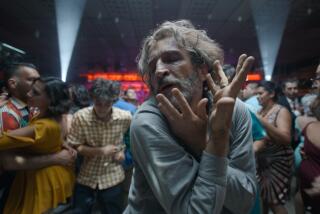MOVIE REVIEW : Easy to See Why ‘La Strada’ Put Fellini on the High Road
- Share via
Before he became too celebrated for a given name, before anyone even thought of tacking “esque” onto his last one, there was a time when Federico Fellini was just another promising Italian director with a background in neo-realism and a few charming films to his credit. Then came “La Strada” and nothing was the same again.
Returning to the Nuart in West Los Angeles for a one-week run, “La Strada” (Italian for “The Road”) appears to have defied time. One of the indelible foreign films of the 1950s (it won an Oscar in 1956), “La Strada” brought a kind of poetry to the screen that dazzled audiences at the time and still works today.
A melding of the neo-realism in Fellini’s past with the fable elements that were to dominate his future, “La Strada” is basically a three-character drama about the nature of loneliness and the elusiveness of love. Using the grit of neo-realism to combat any excessive sentimentality, Fellini and screenplay collaborators Tullio Pinelli and Ennio Flajano fashioned a story that is very simple on one level and anything but on another.
Described on paper, the three protagonists can sound as archetypal as characters on a tarot deck. First comes Zampano (Anthony Quinn), the traveling strong man, a ragged, unshaven lout who motors across Italy performing the same feeble stunt again and again.
As “La Strada” opens, Zampano has purchased the services of the slightly simple Gelsomina (Giulietta Masina) from her mother. She is to serve as his companion and partner in his act, and he treats her as brutally and unfeelingly as the pieces of iron chain he works with.
Very different is Il Matto (the Fool), played by American actor Richard Basehart, a whimsical, sophisticated high-wire clown that Zampano and Gelsomina meet on the road. Unable to resist teasing the cloddish Zampano and taking an interest in Gelsomina, the Fool precipitates a series of crises that end up redefining the lives of all concerned.
More even than Otello Martelli’s cinematography or Nino Rota’s mournful, melodic score, the acting by Basehart, Quinn and Masina defines “La Strada.” Though all are excellent, it is Masina, whose marriage to Fellini gradually curtailed her career, who is most memorable. Part silent clown, part sophisticated child with a face that registers and magnifies every emotion, Masina’s presence is one of the most magical in world cinema, and reason enough all by itself to make this revival worthwhile.
More to Read
Only good movies
Get the Indie Focus newsletter, Mark Olsen's weekly guide to the world of cinema.
You may occasionally receive promotional content from the Los Angeles Times.










